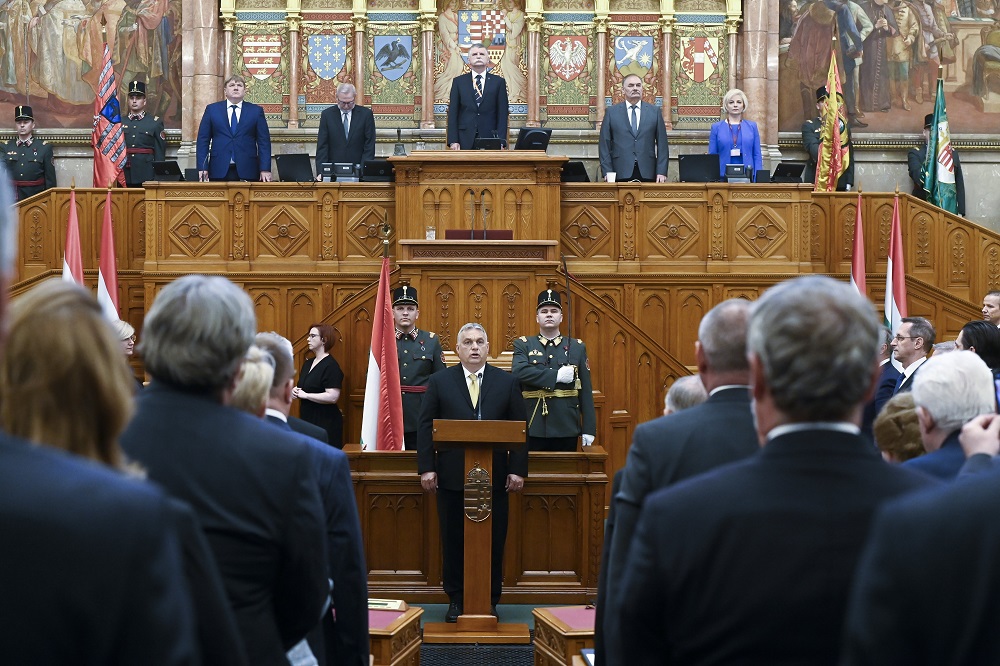All the ingredients for democracy seem to be in place in Hungary, but Telex explains how Viktor Orbán has limited media access to government, parliament and politicians
Tamás Fábián, Máté Szilágyi and Andrea Horváth Kávai (translation), telex
Jul 21, 2022
President of the Fidesz Party Viktor Orban (C) is sworn in as Prime Minister of Hungary after being re-elected for his fourth consecutive term, at the Hungarian Parliament in Budapest. Photo by EPA-EFE/Szilard Koszticsak
This article is published in collaboration with Telex.hu as part of a content series on threats against independent media in Central Europe. Read more
Find the original video on Telex.hu
All the ingredients of democracy seem to be in place in Hungary, but these are only the accessories of Hungarian Prime Minister The illiberal theater of Viktor Orbán. In the video below, we show the gradual shrinking of the public sphere in Hungary, as well as the shrinking space where the critical press can maneuver.
One of Viktor Orbán’s most important political principles is that to succeed in politics and gain power, you need disciplined communication and a loyal media.
The leader of Fidesz has been working on it since the mid-1990s, both in opposition and in government. According to the Prime Minister’s approach, in addition to a press loyal to the party, it is also crucial that the room for maneuver of the media critical of the authorities is as narrow as possible, because even a single negative statement could pose a serious problem.
Since returning to power in 2010, Orbán has introduced a number of measures to help achieve these goals.
In 2010, the press still had a great deal of freedom to work within the precincts of Parliament. But when House Speaker László Kövér changed the House’s statutes, he drastically reduced the chances of the press gaining access to politicians inside parliament. Today the press is only allowed in a small, marked off area, the size of a bus stop, where very few government politicians are willing to stop to answer questions.
Since Viktor Orbán’s office was moved from parliament to the Castle District in 2019, cabinet meetings have been held there instead. Unlike many other Western countries, no advance information is published by the cabinet, and it is not officially known when the most important meetings on the management of the country will be held.
Orbán’s office can be reached via a public area called Színház Street, where – for a time – it was possible to briefly arrest ministers and state secretaries. The situation changed at the end of 2021, when the street was closed for construction, leaving only office workers with access to the entrance. Despite repeated statements from the Prime Minister’s Office, the construction does not impede access to the Prime Minister’s Office, and it is clear that the only reason for fencing the building was to prevent the press from accessing politicians.
All of this is significant because since 2010, Orbán governments have been working to transform the public sphere in Hungary, with the aim of reducing the space available for voices, information and questions critical of the authorities.
To this end, the media law was amended, a new national authority was set up, business circles loyal to the government bought up the most important players in the press market and a Fidesz media holding company, KESMA , was created. KESMA consists of nearly 500 products, which deliver government messages on each platform. In many cases, these pro-government publications are kept alive by publicly funded state advertisements.
Thanks to Orbán’s media policy, a significant part of the electorate only has access to government messages, and voices critical of the government do not reach them. The political leaders of the ruling parties speak to the independent press only on rare occasions. At the same time, the various ministries and official state institutions rarely provide substantive responses to requests from independent media.
It is because of all the above that analysts, journalists and politicians have often criticized Orbán’s media policy as undemocratic.
Watch the video below (with English subtitles) to see more details and get a glimpse of the obstacles facing the still independent Hungarian media.

